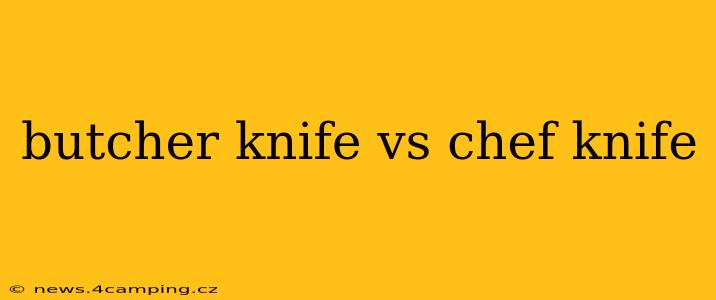Choosing between a butcher knife and a chef's knife can feel like navigating a culinary minefield. Both are essential tools, but their strengths lie in different areas. This comprehensive guide will dissect the key differences, helping you determine which knife – or perhaps both – best suit your cooking style and needs.
What is a Butcher Knife?
A butcher knife, also known as a breaking knife, is characterized by its long, slender blade with a pointed tip. Typically ranging from 8 to 15 inches in length, its primary function is breaking down large cuts of meat. The blade's strength and length allow for precise cuts through bone, cartilage, and tough connective tissues. Its pointed tip is invaluable for piercing and maneuvering around bone structures.
Key Features of a Butcher Knife:
- Length: 8-15 inches
- Blade Shape: Long, slender, pointed tip
- Primary Use: Breaking down large cuts of meat, poultry, and fish; bone removal.
- Ideal for: Butchers, serious home cooks who frequently process whole animals.
What is a Chef's Knife?
The chef's knife, a true workhorse in the kitchen, boasts a versatile curved blade, generally measuring between 6 and 12 inches. Its curved shape allows for a rocking motion, making it ideal for a wide variety of tasks, including chopping, slicing, dicing, and mincing. While it can handle some bone work, it’s not designed for heavy-duty bone-cutting like a butcher knife.
Key Features of a Chef's Knife:
- Length: 6-12 inches
- Blade Shape: Curved, usually pointed or rounded tip
- Primary Use: Chopping vegetables, slicing meat, dicing, mincing, and general food preparation.
- Ideal for: Home cooks, professional chefs, and anyone needing a versatile all-purpose knife.
Butcher Knife vs. Chef Knife: A Head-to-Head Comparison
| Feature | Butcher Knife | Chef's Knife |
|---|---|---|
| Blade Length | 8-15 inches | 6-12 inches |
| Blade Shape | Long, slender, pointed tip | Curved, pointed or rounded tip |
| Primary Use | Breaking down large cuts of meat, bone removal | Chopping, slicing, dicing, mincing |
| Bone Work | Excellent | Limited; can handle smaller bones |
| Versatility | Lower | Higher |
| Weight | Typically heavier | Typically lighter |
Which Knife Do I Need?
The "better" knife depends entirely on your needs.
-
Choose a butcher knife if: You frequently work with whole animals, large cuts of meat, and require a knife specifically designed for breaking down carcasses and removing bones.
-
Choose a chef's knife if: You need a versatile all-purpose knife for a wide range of kitchen tasks, including vegetable preparation, meat slicing, and general food prep. It’s the perfect single knife for most home cooks.
-
Choose both if: You're a serious home cook who enjoys processing whole animals and requires a versatile knife for everyday cooking. This combination offers the ultimate in culinary capability.
How to Choose the Right Size Knife?
Knife size significantly impacts usability. For both butcher and chef's knives, consider:
- Your Hand Size: A larger knife might be unwieldy for smaller hands.
- The Size of Your Cutting Board: Ensure the knife comfortably fits your workspace.
- Frequency of Use: A larger knife may be overkill for infrequent use.
What are the Differences in Blade Steel?
Both butcher and chef knives come in various blade steels, each affecting the knife's durability, sharpness, and maintenance. High-carbon stainless steel is a popular choice for its balance of sharpness, strength, and stain resistance. Other options include high-carbon steel (sharper but more prone to rust) and ceramic (extremely sharp but brittle). Research different steel types to find the best fit for your needs and budget.
What other types of knives should I consider?
Beyond butcher and chef's knives, a well-equipped kitchen often includes a paring knife for detailed work, a serrated knife for bread, and possibly a boning knife for more precise meat preparation. Building a knife set gradually allows for targeted tool acquisition based on your cooking habits.
